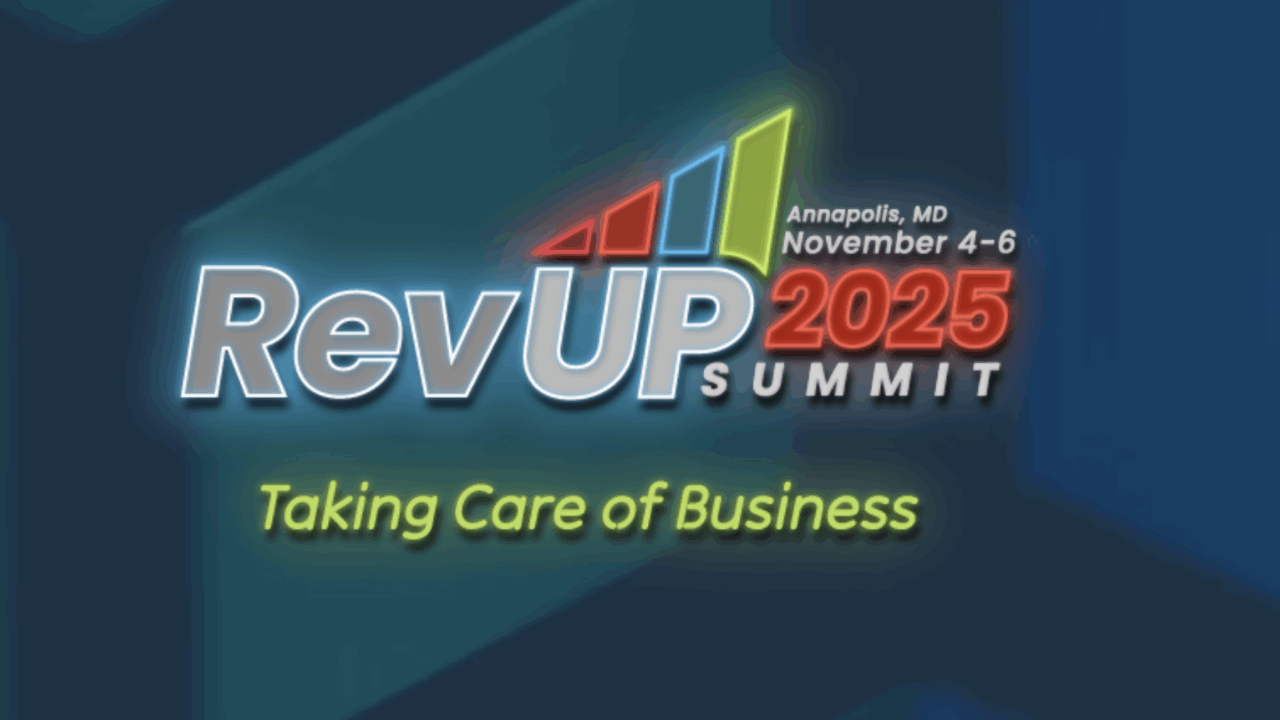From the first RevUP 2025 Summit keynote to the final session, the message was loud and unapologetic: association revenue is everyone’s business — and growth won’t wait for permission.
This wasn’t another association event about playing it safe. It was about asking the hard questions that associations have avoided for too long: what happens when our tried-and-true playbook stalls or stops working, and what if the real barrier to revenue isn’t our market, but our mindset?
Change Isn’t a Project. It’s the Job.
Conferences too often start with soft openings or inspirational moments that make the work of association professionals seem easy. Rhonda Payne opened with a masterclass in uncomfortable truths. Change isn’t something you “roll out.” It’s something your organization lives. Her point hit home: associations don’t fail because of bad ideas — they fail because they can’t execute them fast enough.
Many associations have long histories of serving members with a purpose, but generations and needs change over time. RevUP reframed change leadership as the operating system—not a side initiative organizations run when there’s time or every five years with a new strategic plan. It’s about organizational culture — who’s willing to take risks, fail fast, and adapt quickly. In other words, the speed of change within your association now has to match that outside it. For associations to thrive and grow, it’s no longer an option; it’s what will set apart those who thrive and survive.
Revenue Growth Is a Team Sport—Run One Playbook
Associations have treated membership, sales, marketing, and education as separate functions within their organization. Each of them has their own data, goals, and metrics. RevUP blew them up and pushed everyone toward a new mindset: a single growth engine powered by collaboration, not silors or competition between departments. It’s not about who gets the credit — it’s about how association growth.
Remember those member personas that either never got developed or are gathering dust in a binder? Understanding pain points, buying triggers, communication preferences, etc., must come together rather than living in separate silo playbooks.
Simply put: Marketing earns trust. Sales converts it. Membership and education deliver it. Events amplify it.
AI Isn’t the Future — It’s the Association Amplifier.
With the buzzword “AI” reaching a crescendo in every newsletter, conference session, and boardroom discussion, RevUP speakers cut through the noise. Colleen McKenna’s sessions on AI and LinkedIn strategy reframed the conversation: AI isn’t about automating the human out of the equation; it’s about scaling connections.
When used right, it helps you listen better, personalize more deeply, and communicate with relevance. When used incorrectly, it becomes a soulless content machine, shouting into the void.
The insight? Technology won’t save your association. But the people who learn how to use it meaningfully might.
Programs Are Products. Price the Transformation.
One of the more provocative insights from RevUP was that associations need to stop launching programs like campaigns and start managing them like products (yes, think like a business). Products have positioning, life cycles, sunsetting criteria, and pricing logic that signal confidence.
Underpricing screams, “We’re not sure.” Overpricing without proof screams, “We’re guessing.” Price the outcome: career acceleration, value, brand, and network access. Then deliver the proof—testimonials, case studies, placement stats, exhibitor and sponsor ROI, etc..
Every revenue line should have a one-page product brief—who it’s for, the problem it solves, what we expect to learn this quarter, and the kill/scale thresholds. If you can’t write it in plain English, it isn’t ready.
Boards: From Compliance to Acceleration
One undercurrent throughout many sessions is that boards can be growth engines—or parking brakes. Yesterday’s association board culture prized caution; tomorrow’s must prize clarity and pace. That doesn’t mean ignoring risk—quite the opposite. It means defining thresholds for acceptable risk to ensure relevance to the membership and the causes they serve.
Turn the board into a strategic accelerator and ask for outcomes and not outputs. Set expectations and give your board two dashboards each quarter—one on progress against member outcomes, one on experiments in flight. If they only see dollars and not learning, they’ll optimize for the wrong thing.
The Annual Conference Is Your Most Honest Focus Group
You don’t need another survey to know what your membership thinks. Walk your annual conference or convention show floor with a notebook. Listen to questions. Track the sessions that empty early and the ones that require extra seats. That’s not logistics—it’s live R&D. Capture top questions from sessions and turn them into next-quarter content. Ask exhibitors for the three objections they hear most often—fold them into sales enablement for your exhibit and sponsorship sales team. Events can be the most curated moments of all your efforts. Not leveraging them for market research is a missed opportunity.
Stop Selling Benefits. Start Selling Belonging
Amid all the sessions on metrics, data, and AI, one truth cut through: community is the most undervalued asset in the association world.
Association professionals have been conditioned to market features such as white papers, discounts, member directories, and CEUs. RevUP’s subtext was louder: members buy identity, not inventory. The most persuasive “benefit” is the feeling of being in the room where people like themselves are solving problems like theirs, faster than they can alone.
That’s why community intelligence is the currency. Discussion threads, peer benchmarks, exhibitor roundtables, backstage AMAs with subject-matter insiders—these aren’t fluff. They are the IP your competitors can’t replicate. You can copy a conference agenda. You cannot copy a community that trusts each other.
Know your demographics deeply: write a one-paragraph “day in the life” for each key persona—what frustrates them on Tuesday at 4:30 pm? What would make Wednesday feel lighter? Then build programming that steals back 60 minutes of their week. They will line up for that.
The Real Disruption: Member Expectations
Not AI. Not budgets. Expectations. Your members now live in a world of one-click convenience, algorithmic relevance, and bingeable learning—and they don’t lower those standards when they log into any association website or portal. RevUP’s unspoken dare: design like you’ve used Netflix, Amazon, LinkedIn, and Duolingo—because your members have, today.
These practical shifts should lead to modular education with microlearning, just-in-time content (surfacing what matters when it matters), and frictionless paths (registration, renewal, referral—all three should feel easy).
Set expectations: commit to one “friction search” each month—pick a journey (join, register, sponsor,etc) and work on reducing friction or confusion.
Revenue and Mission Are Multipliers, Not Enemies
RevUP pushed an overdue reframe: money isn’t the opposite of mission; it’s the multiplier. Associations that apologize for revenue, underfund impact. Associations that master value creation—then price and package it with pride—extend their mission, not betray it.
Put another way: if your work changes careers, companies, or communities, charge with confidence. Then show the receipts—impact reports your board can celebrate and your market can believe.
Involving your memberships and sharing out member success stories, advocacy and policy wins, industry improvements or whatever fuels your association members’ needs, tie them back to your organization and that their membership (dues and dollars) made it possible.
The Reflection: A Wake-Up Call in Disguise
RevUP 2025 wasn’t about finding a single “big idea.” It was about connecting the dots between lots of small, impactful ones. It also made it clear that growth doesn’t come from one idea, one department, or one area of your association — it comes from clarity, consistency, and being bold to act. Assuming that associations with the biggest budgets will win is a false narrative; it’s the ones that are brave enough to evolve — and fast enough to keep up.















